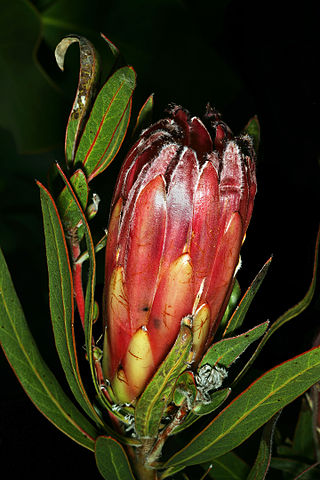
Jacaranda mimosifolia is a sub-tropical tree native to south-central South America that has been widely planted elsewhere because of its attractive and long-lasting violet-colored flowers. It is also known as the jacaranda, blue jacaranda, black poui, Nupur or fern tree. Older sources call it J. acutifolia, but it is nowadays more usually classified as J. mimosifolia. In scientific usage, the name "jacaranda" refers to the genus Jacaranda, which has many other members, but in horticultural and everyday usage, it nearly always means the blue jacaranda.

Melhania is a genus of small shrubs or herbaceous plants. Traditionally included in the family Sterculiaceae, it is included in the expanded Malvaceae in the APG and most subsequent systematics. The genus is named for Mount Melhan in Yemen.

South Africa, officially the Republic of South Africa (RSA), is the southernmost country in Africa. It is bounded to the south by 2,798 kilometres (1,739 mi) of coastline that stretch along the South Atlantic and Indian Oceans; to the north by the neighbouring countries of Namibia, Botswana, and Zimbabwe; and to the east and northeast by Mozambique and Eswatini. It also completely enclaves the country Lesotho. It is the southernmost country on the mainland of the Old World, and the second-most populous country located entirely south of the equator, after Tanzania. South Africa is a biodiversity hotspot, with unique biomes, plant and animal life. With over 60 million people, the country is the world's 24th-most populous nation and covers an area of 1,221,037 square kilometres. South Africa has three capital cities, with the executive, judicial and legislative branches of government based in Pretoria, Bloemfontein, and Cape Town respectively. The largest city is Johannesburg.

Pechuel-loeschea, is a monotypic genus of African plants in the elecampane tribe within the sunflower family, and named after the German plant collector and geographer Eduard Pechuël-Loesche (1840-1913).

Burchell's coucal is a species of cuckoo in the family Cuculidae. It is found in the southeastern parts of sub-Saharan Africa. It inhabits areas with thick cover afforded by rank undergrowth and scrub, including in suitable coastal regions. Common names include gewone vleiloerie in Afrikaans and umGugwane in Zulu. It is sometimes considered a subspecies of the white-browed coucal, which replaces it to the north and west. The juvenile plumages and calls of the two taxa are hardly distinguishable. The species is named after the British naturalist William John Burchell.

Mairia burchellii is a tufted perennial plant of up to 15 cm (6 in) assigned to the family Asteraceae. It has narrow leaves of up to 5 mm (0.20 in) wide, with single main vein and an entire margin. Flower heads only occur after a fire has destroyed the standing vegetation, mostly in November or between February and June. The flower heads sit individually or with a few on the tip of a purplish stalk, with a few narrow bracts, and consist of a row of pinkish ray florets around many yellow disc florets. It can be found in the southwest of the Western Cape province of South Africa.
Melhania didyma is a plant in the mallow family Malvaceae, native to southern Africa.
Melhania integra is a plant in the mallow family Malvaceae, native to South Africa.
Melhania randii is a plant in the mallow family Malvaceae, native to southern Africa. It is named for the English doctor and plant collector R.F. Rand (1856–1937).
Melhania forbesii is a plant in the mallow family Malvaceae, native to southern Africa. It is named for the English naturalist and plant collector John Forbes.
Melhania polygama is a plant in the mallow family Malvaceae, native to South Africa.
Melhania rehmannii is a plant in the family Malvaceae, native to southern Africa. It is named for the Polish botanist and geographer Anton Rehmann.
Melhania transvaalensis is a plant in the family Malvaceae, native to South Africa.
Melhania virescens is a plant in the mallow family Malvaceae, native to southern Africa.
Melhania damarana is a plant in the family Malvaceae, native to southern Africa.
Melhania suluensis is a plant in the family Malvaceae, native to southern Africa.

Cola greenwayi, commonly known as hairy cola or Zulu coshwood, is a species of flowering plant in the family Malvaceae. It was first described in 1956 by the British botanist John Patrick Micklethwait Brenan. It is native to southeastern Africa.
Melhania latibracteolata is a plant in the family Malvaceae, native to East Africa.
Melhania velutina is a plant in the family Malvaceae, native to Africa and the Arabian Peninsula.

Protea burchellii, also known as Burchell's sugarbush, is a flowering shrub in the genus Protea, which is endemic to the southwestern Cape Region of South Africa.







